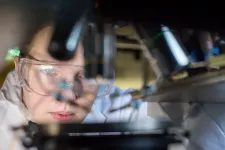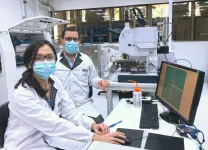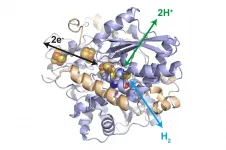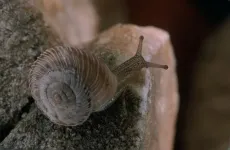INFORMATION:
The study, Flexible Amino Acid-Based Energy Harvesting for Structural Health Monitoring of Water Pipes by Favour Okosun, Sarah Guerin, Mert Celikin and Vikram Pakrashi, has just been published by the journal Cell Reports Physical Science and is available here: https://www.cell.com/cell-reports-physical-science/fulltext/S2666-3864(21)00129-6.
For further information, please contact:
Alan Owens
Communications Officer
University of Limerick
+353 87 908 6633
alan.owens@ul.ie
About University of Limerick:
The University of Limerick is an independent, internationally focused university with 16,500 students and 1,700 staff. It is a young, energetic and enterprising university with a proud record of innovation in education and excellence in research and scholarship.
More information is available at http://www.ul.ie. END
Eco-friendly device developed at UL, Ireland detects real-time pipe damage
A University of Limerick, Ireland researcher has developed a low-cost, environmentally friendly sensor that can detect damage in pipelines and could save water as a result.
2021-05-12
(Press-News.org) A researcher at University of Limerick has developed a low-cost, environmentally friendly sensor that can detect damage in pipelines and could save water as a result.
The damage detection sensor uses highly sensitive, eco-friendly crystals that generate an electrical signal in response to a leak.
It is the first validation of these biological crystals for real world applications, according to Dr Sarah Guerin, a postdoctoral researcher at the Department of Physics and the Bernal Institute in UL, who has been developing amino acid crystal devices since 2017.
An Irish research collaboration between the Bernal Institute at UL and the Dynamical Systems and Risk Laboratory in University College Dublin has validated the crystal-based sensor.
The journal Cell Reports Physical Science has just published a study on the findings of the innovative research.
"The sensor is made of crystallised amino acids that are sensitive enough to detect leaks as small as 2mm," said Dr Guerin.
"Computer simulations show that they generate electricity in response to a force - such as strain or vibration - known as the piezoelectric effect.
"Biomolecular piezoelectric materials such as these offer an inexpensive, non-toxic and renewable alternative to current commercial piezoelectric devices, which rely on toxic heavy elements or require heavy processing," she explained.
Leak detection in fluid-carrying pipes is crucial for sustainable water access, and vibration-based techniques have proven to be effective at early detection of leak onset. Current commercial solutions are either battery powered, or if piezoelectric, very costly.
In addition, most commercial accelerometers have rigid structures, making them unsuitable for bonding to curved pipes, explained the UL researcher.
"This sensor has a number of advantages over current technologies," said Dr Guerin.
"It is flexible, cheap to make, and outperforms ceramics and polymers that are used in these structural health monitoring applications. The fabrication process is suitable for mass production of these devices," she added.
Professor Vikram Pakrashi of UCD, a senior author on the study who has developed extensive testing facilities for validating materials for structural health monitoring that simulate infrastructural damage in for example buildings and pipelines, said the findings of the research were significant.
"These amino-acid-based sensors will provide real-time sensing of pipe degradation, allowing for data-driven decision making on repair and maintenance, aiding in the global challenge of equitable water access," he explained.
"This is the first time such materials have been applied for real engineering problems and it has addressed one of the core challenges of our time - water," added Dr Favour Okosun of UCD, whose doctoral research created the application of this sensor.
ELSE PRESS RELEASES FROM THIS DATE:
A new bridge between the geometry of fractals and the dynamics of partial synchronization
2021-05-12
In mathematics, simple equations can generate a complex evolution in time and intriguing patterns in space. One famous example of this is the Mandelbrot set, named after the French-American mathematician of Polish origin, Benoit B. Mandelbrot (1924-2010), the most studied fractal. This set is based on a single quadratic equation with only one parameter and one variable. The fascinating fractal patterns of the Mandelbrot set have attracted attention far beyond mathematics.
An article by Ralph Andrzejak, entitled "Chimeras confined by fractal boundaries in the complex plane", forms part of a special edition of the journal Chaos in memory of Russian professor Vadim S. Anishchenko, (1943-2020), published on 3 May 2021. Andrzejak is head of the Nonlinear Time Series Analysis Group ...
NUS scientists create a new type of intelligent material
2021-05-12
Intelligent materials, the latest revolution in the field of materials science, can adapt their properties depending on changes in their surroundings. They can be used in everything from self-healing mobile phone screens, to shape-shifting aeroplane wings, and targeted drug delivery. Delivering drugs to a specific target inside the body using intelligent materials is particularly important for diseases like cancer, as the smart material only releases the drug payload when it detects the presence of a cancer cell, leaving the healthy cells unharmed.
Now, researchers from the Centre ...
Scientists design new drug compound to stop malaria in its tracks
2021-05-12
Researchers at the Francis Crick Institute and the Latvian Institute of Organic Synthesis have designed a drug-like compound which effectively blocks a critical step in the malaria parasite life cycle and are working to develop this compound into a potential first of its kind malaria treatment.
While drugs and mosquito control have reduced levels of malaria over recent decades, the parasite still kills over 400,000 people every year, infecting many more. Worryingly, it has now developed resistance to many existing antimalarial drugs, meaning new treatments that work in different ways are urgently needed.
In their research, published in PNAS, the scientists developed a set of compounds designed to stop the parasite being able to burst out of red ...
Low levels of a simple sugar -- A new biomarker for severe MS?
2021-05-12
Multiple sclerosis, or MS for short, manifests itself slightly differently in each person - which is why some call it "the disease of a thousand faces." Arguably the worst manifestation of MS is its chronic progressive form. Unlike the more common relapsing-remitting variant (RRMS), in which sufferers are often symptom-free for months or even years, patients with the primary progressive form of the disease (PPMS) see their condition steadily deteriorate with no remissions.
Poorly insulated neurons die off
Today's therapeutic approaches are based on the assumption that the immune system is making a mistake and waging an inappropriate attack on the layer of myelin that surrounds and insulates the nerve cells' long, ...
Interactive typeface for digital text
2021-05-12
AdaptiFont has recently been presented at CHI, the leading Conference on Human Factors in Computing.
Language is without doubt the most pervasive medium for exchanging knowledge between humans. However, spoken language or abstract text need to be made visible in order to be read, be it in print or on screen.
How does the way a text looks affect its readability, that is, how it is being read, processed, and understood? A team at TU Darmstadt's Centre for Cognitive Science investigated this question at the intersection of perceptual science, cognitive ...
Giant sea lizard fossil shows diversity of life before asteroid hit
2021-05-12
A giant mosasaur from the end of the Cretaceous period in Morocco that could have reached up to eight metres long is the third new species to be described from the region in less than a year, bringing the total number of species up to at least 13.
The high diversity of the fauna shows how mosasaurs, giant marine lizards related to snakes and Komodo dragons, thrived in the final million years of the Cretaceous period before they, and most of all species on Earth, were wiped out by the impact of a giant asteroid 66 million years ago.
The new species, named Pluridens serpentis, had long, slender jaws with over a hundred sharp, ...
Efficiently smuggling drugs into cells
2021-05-12
Modern vaccines such as those against Sars-CoV-2 use tiny lipid spheres to transport genetic information into cells and let the body build up an immune defense against the virus. A team of scientists from Erlangen, Dresden, and London has now developed a completely new method to very efficiently deliver not only genes but also drugs and other substances into cells. The researchers from the Max-Planck-Zentrum für Physik und Medizin (MPZPM) in Erlangen, the Technical University of Dresden, and The Institute of Cancer Research in London have named the method Progressive Mechanoporation and have now published it in the scientific journal "Lab on a Chip". They have also filed a patent.
Ruchi Goswami and Alena Uvizl were part of a team of scientists led by Salvatore Girardo (Erlangen) ...
An enzyme system for the hydrogen industry
2021-05-12
An enzyme could make a dream come true for the energy industry: It can efficiently produce hydrogen using electricity and can also generate electricity from hydrogen. The enzyme is protected by embedding it in a polymer. An international research team with significant participation of scientists from Technical University of Munich (TUM) has presented the system in the renowned science journal Nature Catalysis.
Fuel cells turn hydrogen into electricity, while electrolysers use electricity to split water to produce hydrogen. Both need the rare and thus expensive precious metal platinum as a catalyst. Nature has created a different solution: Enzymes, referred to as hydrogenases. ...
Locomotion Vault will help guide innovations in virtual reality locomotion
2021-05-12
Experts in virtual reality locomotion have developed a new resource that analyses all the different possibilities of locomotion currently available.
Moving around in a virtual reality world can be very different to walking or employing a vehicle in the real world and new approaches and techniques are continually being developed to meet the challenges of different applications.
Called Locomotion Vault, the project was developed by researchers at the Universities of Birmingham, Copenhagen, and Microsoft Research. It aims to provide a central, freely-available ...
Xerocrassa montserratensis, an endemic and threatened snail in Catalonia
2021-05-12
A study published in the journal Scientific Reports reveals the genetic structure of the land snail Xerocrassa montserratensis and it provides new scientific tools for the improvement of the conservation of this endemic and threatened species in Catalonia. This land mollusc, identified in the late 19th century in the Montserrat mountain, has a reduced geographical distribution limited to the province of Barcelona, and it is a protected species in the area of the natural parks of Montserrat and Sant Llorenç del Munt i l'Obac.
The study is led by the lecturer Marta Pascual, from the Faculty of Biology and the Biodiversity Research Institute of the University of Barcelona ...
LAST 30 PRESS RELEASES:
Why nail-biting, procrastination and other self-sabotaging behaviors are rooted in survival instincts
Regional variations in mechanical properties of porcine leptomeninges
Artificial empathy in therapy and healthcare: advancements in interpersonal interaction technologies
Why some brains switch gears more efficiently than others
UVA’s Jundong Li wins ICDM’S 2025 Tao Li Award for data mining, machine learning
UVA’s low-power, high-performance computer power player Mircea Stan earns National Academy of Inventors fellowship
Not playing by the rules: USU researcher explores filamentous algae dynamics in rivers
Do our body clocks influence our risk of dementia?
Anthropologists offer new evidence of bipedalism in long-debated fossil discovery
Safer receipt paper from wood
Dosage-sensitive genes suggest no whole-genome duplications in ancestral angiosperm
First ancient human herpesvirus genomes document their deep history with humans
Why Some Bacteria Survive Antibiotics and How to Stop Them - New study reveals that bacteria can survive antibiotic treatment through two fundamentally different “shutdown modes”
UCLA study links scar healing to dangerous placenta condition
CHANGE-seq-BE finds off-target changes in the genome from base editors
The Journal of Nuclear Medicine Ahead-of-Print Tip Sheet: January 2, 2026
Delayed or absent first dose of measles, mumps, and rubella vaccination
Trends in US preterm birth rates by household income and race and ethnicity
Study identifies potential biomarker linked to progression and brain inflammation in multiple sclerosis
Many mothers in Norway do not show up for postnatal check-ups
Researchers want to find out why quick clay is so unstable
Superradiant spins show teamwork at the quantum scale
Cleveland Clinic Research links tumor bacteria to immunotherapy resistance in head and neck cancer
First Editorial of 2026: Resisting AI slop
Joint ground- and space-based observations reveal Saturn-mass rogue planet
Inheritable genetic variant offers protection against blood cancer risk and progression
Pigs settled Pacific islands alongside early human voyagers
A Coral reef’s daily pulse reshapes microbes in surrounding waters
EAST Tokamak experiments exceed plasma density limit, offering new approach to fusion ignition
Groundbreaking discovery reveals Africa’s oldest cremation pyre and complex ritual practices
[Press-News.org] Eco-friendly device developed at UL, Ireland detects real-time pipe damageA University of Limerick, Ireland researcher has developed a low-cost, environmentally friendly sensor that can detect damage in pipelines and could save water as a result.




